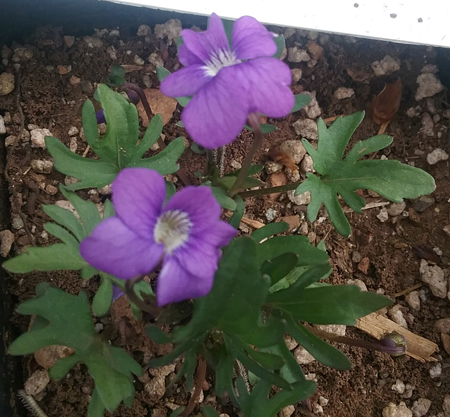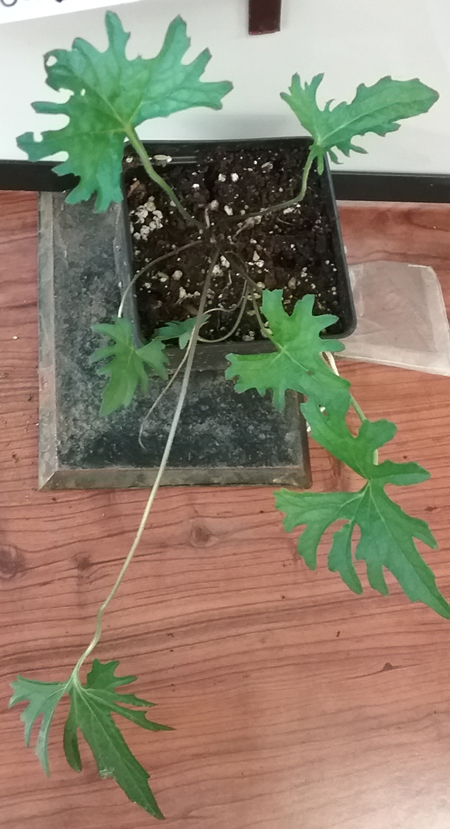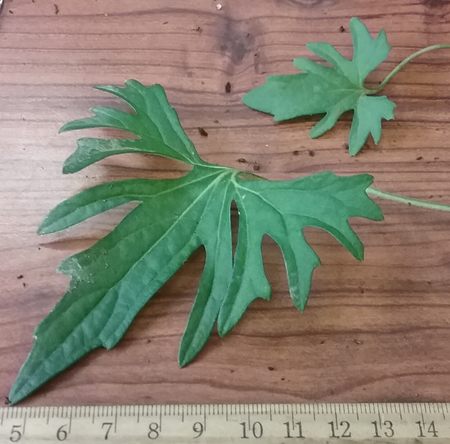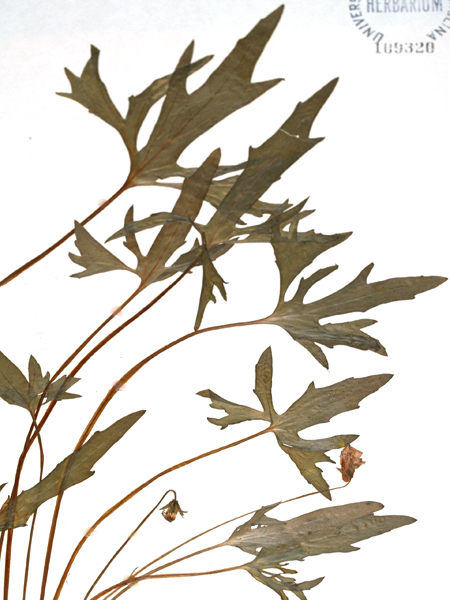Viola monacanora J.L.Hastings & H.E.Ballard, ined.
Common names:
Blue Ridge Violet
Synonyms:
None.
Description:
Acaulescent rosulate perennials from thick rhizome, ≤ 20 cm tall; foliage and peduncles dark green, petioles, lower surface of leaf blades and peduncles purple-tinged, glabrous (petioles rarely sparsely hirsute, possibly the result of hybridization with ubiquitous V. sororia); stipules free, irregularly glandular-fimbriate; homophyllous, leaves ascending, smallest leaf blades palmatifid, largest palmatifid to subbiternate, in fruit becoming deeply biternately divided into 9–11(13) usually falcate linear or linear-lanceolate apically asymmetrically angulate lobes, ≤ 60 × 55 mm, outline narrowly ovate-triangular during chasmogamous flower but broadening to ovate in fruit, base cordate, margins of ultimate lobes entire or sporadically appressed-crenate, eciliate, apex acute to obtuse; chasmogamous peduncle held among the leaves; chasmogamous flower ≤ 22 mm; calyx glabrous, eciliate; lowest sepals lance- to ovate-triangular, acute or acuminate; auricles short and entire, not elongating in fruit or scarcely so to 1 mm; corolla blue to purple, throat white; spur short-globose; lateral petals densely bearded with slightly clavate hairs, spurred petal glabrous; chasmogamous capsule green; cleistogamous flowers produced after chasmogamous, peduncle prostrate but arching just before dehiscence, shorter than petioles; cleistogamous capsule 5–8 mm, green drying tan or purple-tinged with purple blotches, glabrous; seeds 1.8–2.1 × 1.2–1.4 mm, blackish with minute raised black reticulations.
Similar species:
This species is most similar to V. subsinuata, from which it differs in strictly or nearly glabrous foliage, a narrower blade outline with slender falcate sharply acutish ultimate segments, sharply acute eciliate sepals, and dark minutely marked seeds. While V. subsinuata is now known as a rare occurrence in the Blue Ridge Mountains, but thus far this species is strictly endemic to that mountain range.
Ecology:
Moist rocky loam soils in rich mesic forests at higher elevations in the Appalachian Mountains.
Distribution:
Blue Ridge Mountain range, W.-c. VA south to nw. NC.
Rarity:
None.
Phenology:
Chasmogamous flower April–May, chasmogamous fruit May–June, cleistogamous fruit July–September.
Affinities:
This species belongs to the Acaulescent Blue Violet lineage, sect. Nosphinium W.Becker, subsect. Boreali-Americanae (W.Becker) Gil-ad, in the Subsinuata species group.
Hybrids:
Hybridizes with V. sororia (Hastings 2018, Harvey Ballard pers. comm.). No information is available on reproductive behavior of the hybrid.
Comments:
As with V. baxteri House, this violet was included in a broadly delimited V. palmata by Brainerd (1921b), Brainerd Baird (1942), Fernald (1950), Alexander (1963), Russell (1965), Scoggan (1978), and Strausbaugh (1978); the complex was later called V. subsinuata by McKinney (1992), Ballard (2000), Weakley et al. (2012), and Little and McKinney (2015). Gil-ad (1995, 1997, 1998) dismissed the assemblage as a series of hybrid derivatives (for more information see comments under V. baxteri and V. subsinuata sensu lato). Jennifer Hastings (2018) completed her taxonomic thesis research on this and other cut-leaved violets in the Subsinuata species group (plus V. palmata) in Virginia, presenting evidence for the recognition of this newly segregated evolutionary species. It is as yet very rare in herbaria, thus far known from one confirmed herbarium specimen from Virginia (Augusta Co., along Blue Ridge Parkway at Alton [sic!--Afton], 2 Jul 1953, W. E. Buker 15769, CM215697) and one from North Carolina (Wilkes Co., 4 miles east of Moravian Falls, 13 May 1956, A. E. Radford 11231, NCU). It is distinct from other homophyllous cut-leaved violets, especially during cleistogamous fruit, in the strictly glabrous foliage (the petioles uncommonly sparsely hirtellous), peduncles and eciliate calyces, with lower surface of leaf blades, petioles, peduncles, and calyces strongly tinged with purple, the narrow and deeply biternately divided leaf blades with linear apically angulate lobes, slender acuminate sepals, and blackish seeds with minute black raised reticulations. It is restricted to moist rocky loam soils of rich mesic forests as a regional endemic of the Blue Ridge province in the Appalachian Mountains. Its southernmost extent is based currently on the herbarium specimen from Moravian Falls area of northwestern North Carolina, and it should be sought further south in the Blue Ridge mountain range. The specific epithet honors the hardy peoples of the Monacan First Nation, who relatively recently received federal recognition after a decades-long battle, and who have lived for millenia around the northern portion of the Blue Ridge Mountain range where this violet was first discovered as living populations. V. subsinuata sensu stricto occasionally grows near it and V. sororia commonly grows commingled with it. Hybrid plants with moderately hirsute foliage and shallowly lobed leaf blades, representing crosses with V. sororia, are common and sometimes outnumber plants of V. monacanora along and near roadsides and other disturbed areas.
Literature Cited:
Alexander, E. J. 1963. Violaceae. In Gleason, H. A., The new Britton and Brown illustrated flora of the northeastern United States and adjacent Canada. Hafner Publishing Co., Inc., New York, NY. 552-567.
Ballard Jr., H. E. 2000. Violaceae. In Rhoads, A. (ed.). Flora of Pennsylvania. University of Pennsylvania Press, Philadelphia, PA. 700-710.
Brainerd, E. 1921b. Violets of North America. Vermont Agricultural Experiment Station Bulletin 224: 1-172.
Brainerd Baird, V. 1942. Wild violets of North America. University of California Press, Berkeley, CA.
Fernald, M. L. 1950. Violaceae. In Gray’s Manual of Botany, 8th ed. American Book Company, New York, NY. 1022-1042.
Gil-ad, N. L. 1995. Systematics and evolution of Viola L. subsection Boreali-Americanae (W. Becker) Brizicky. Ph.D. dissertation. University of Michigan, Ann Arbor, MI.
Gil-ad, N. L. 1997. Systematics of Viola subsection Boreali-Americanae. Boissiera 53: 1-130.
Gil-ad, N. L. 1998. The micromorphologies of seed coats and petal trichomes of the taxa of Viola subsect. Boreali-Americanae (Violaceae) and their utility in discerning orthospecies from hybrids. Brittonia 50: 91-121.
Hastings, J. L. 2018. Systematic and ecological studies of the Viola subsinuata species complex. M.S. thesis. Ohio University, Athens, OH.
Little, R. J., and L. E. McKinney. 2015. Violaceae. In Flora of North America: Cucurbitaceae to Droseraceae, 106. Oxford University Press, New York, NY.
McKinney, L. E. 1992. A taxonomic revision of the acaulescent blue violets (Viola) of North America. Sida, Botanical Miscellany 7: 1-60.
Russell, N. H. 1965. Violets (Viola) of the central and eastern United States: An introductory survey. Sida 2: 1-113.
Scoggan, H. J. 1978. Violaceae. In Flora of Canada, Part 3–Dicotyledoneae (Saururaceae to Violaceae). National Museums of Canada. Ottawa, Canada. 1103-1115.
Strausbaugh, P. D. and E. L. Core. 1978. Violaceae. In Flora of West Virginia, 2nd ed. Seneca Books, Inc., Morgantown, WV. 644-658.
Weakley, A. S., J. C. Ludwig, and J. F. Townsend. 2012. Violaceae. In Flora of Virginia. BRIT Press, Fort Worth, TX. 963-975.

Chasmogamous flowering habit by Harvey Ballard

Chasmogamous flowering habit by Jennifer Hastings

Cleistogamous fruiting habit (plant transplanted from VA, Augusta Co., Blue Ridge Parkway, west of Greystone Farm north-northwest of Love Gap) by Jennifer Hastings

Leaves during cleistogamous fruit (plant transplanted from VA, Augusta Co., Blue Ridge Parkway, west of Greystone Farm north-northwest of Love Gap) by Jennifer Hastings

Leaves during chasmogamous fruit from herbarium specimen: NC, Wilkes Co., 4 miles east of Moravian Falls, Mixed deciduous forest, 13 May 1956 (NCU109320)

Cleistogamous fruits (plant transplanted from VA, Augusta Co., Blue Ridge Parkway, west of Greystone Farm north-northwest of Love Gap) by Jennifer Hastings

Seeds from herbarium specimen: Transplanted from VA, Blue Ridge Mountains, S of Afton, 13 Aug 2014, H. Ballard & A. Stuart s.n. (BHO)

Seeds (plant transplanted from VA, Augusta Co., Blue Ridge Parkway, west of Greystone Farm north-northwest of Love Gap) by Jennifer Hastings

Map of the Subsinuata species group by Harvey Ballard